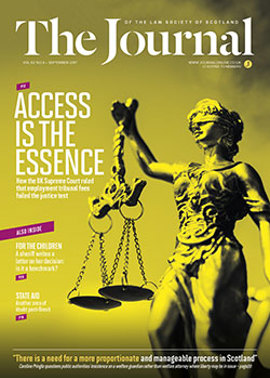The Land Register: two ticking timebombs
Earlier this year I celebrated the 45th anniversary of my starting work in the profession as a raw apprentice. I still remember the thrill of drafting my first disposition for a real life client and telephoning my father, also a solicitor, to tell him of my excitement. In those days, Registers of Scotland was a much respected organisation. A call from the registers, whilst never welcome as it usually meant a flaw in a submitted deed, always resulted in a discussion with someone of experience at Register House who was happy to provide guidance on what might be required to sort out the problem. Contrast that with the present position, where the simplest query is met with several days' delay.
Looking at their website in early September this year, it seems that they can only manage to register 67.4% of “non-standard” first registrations (i.e. not in a research area) within the target of six months. For part registrations, it falls to 63.4% within nine months. Is that not scandalous? Should Registers of Scotland not now recognise the need to transfer resources from the politically driven “complete the Land Register by 2024” project to ensure that, at the very least, they are able to register 100% of first and part registrations within their target? The 2012 Act has proved a nightmare for solicitors, as has been well publicised by recent articles in the Journal and the Gazette of the Scottish Law Agents Society. Like one author, I consider that the rejection scenario is inevitably going to lead to a high-profile indemnity claim.
My main purpose in writing, however, is to draw the attention of the profession to two matters which appear not to be widely known.
Ticking timebomb number one...
Last year I dealt with a sale transaction for clients who had owned their property for some 10 years. I acted in the purchase and held the original land certificate. There had been no transactions on the title. I sent the land certificate to the purchaser’s solicitor who had by that time ordered a copy from the Land Register. I received a surprised phone call from him to say that my clients appeared to own two properties. The title he had received from Registers Direct confirmed this, with two non-contiguous properties shown coloured. I knew that this was not the case and immediately contacted Registers of Scotland. They admitted that there was an error, which they then corrected and returned the title to me without comment.
I was understandably dissatisfied that no explanation had been given and asked them to explain how this error had arisen. They were very reluctant to tell me, but the eventual answer was that:
“The Ordnance Survey map on which your client’s title plan [sic] is at a base scale of 1/2500. This is the largest scale mapping for rural areas and covers almost 70% of Great Britain, however this base scale held the most anomalies and inconsistencies. This was due to the fact that transformation of old mapping from individual county projections to a modern national grid, over a period of time caused inaccuracies.
“To address these problems Ordnance Survey instigated its Post Accuracy Improvement (PAI) programme with the aim of bringing all 1/2500 scale data within a uniform resurvey specification. The repercussion of PAI for Registers of Scotland is that all registered titles have had to be migrated to the new post PAI version of the map which is included in your client's title.
“Due to the large number of titles sheets affected, Registers of Scotland completed an automated conversion process to update these titles, however in this particular instance an error has occurred in introducing the additional pink tint. I am unaware of any other title sheets affected. I apologise for this and thank you for bringing it to the Keeper’s attention.”
Again understandably, I was less than reassured by this explanation and Registers of Scotland arranged for a senior plans officer to call me to explain further. He explained that some 300,000 titles were involved in this remapping project. Apparently these are mostly in rural areas. He could not give any explanation as to how this error, which he described as a “rogue polygon”, could have arisen. He told me that he was confident that because of “the procedures in place”, problems only affected “a very small number of titles”. The project ran from 2005 to 2011 or so, and because of the large number of titles, software was commissioned to assist the process. Amongst other things he told me was that, if a title boundary was within a certain distance of an OS feature which had moved, the title boundary would move with it. He told me that the Keeper has no plans to review all these titles.
It strikes me that this particular error was only discovered because it was so blatant that it was clearly wrong and I was intimately familiar with my client's “real” title. Anyone simply getting a copy from Registers Direct would have assumed that my client owned two properties. Huge confusion would have arisen. So much for the “purity” of the register. There may well be other subtle changes introduced into these 300,000 titles throughout Scotland which have not been picked up and which are sitting unnoticed.
The fact that Registers of Scotland say they are “not aware of any errors” does not really give any confidence that there are none, since this is only going to be discovered (if at all) as and when solicitors have occasion to check their clients' titles on a sale or other transaction. Registers of Scotland themselves gave no notice that this was being done, nor did they send copies of the amended titles to affected proprietors. Only the proprietors or their solicitors could know for certain whether these changes correctly reflected the title of the property, yet these were the very people that Registers of Scotland deliberately kept in the dark. Anyone getting a copy from Registers Direct of an affected title has no way of knowing whether or not it has been altered by these Ordnance Survey changes. The date on the title plan may give a clue, but only if the solicitor concerned is alert to the possibility.
It seems to me that this sorry tale displays an arrogance and lack of concern at Registers of Scotland which beggars belief.
Ticking timebomb number 2...
At a seminar in Inverness last year the Keeper herself made an appearance. With the above episode fresh in my mind, I asked her whether it was intended that property owners whose title was to be affected by Keeper-induced registration would be given notice that the title was to be changed. I was told by her that this was not seen to be necessary but that a copy of the completed title would be sent out once the process had been completed. I was not terribly happy about that, and found it hard to believe a colleague who recently told me that it is not now intended to send out a copy of the completed title to each affected proprietor. An enquiry to the Keeper elicited the following response:
“Thank you for your enquiry about KIR. Following the KIR consultation, which concluded in February 2016, Registers of Scotland spent an extensive period of time refining the intended KIR process and this included the appropriate means of notifying homeowners and their legal representatives that KIR has taken place.
“The means of notification chosen is to clearly identify KIR on Land Register titles so that owners, or their agents, are fully aware of the route of the title at the time of the next transaction. Additionally a closing note is added to the sasine record for each KIR title along with the Land Register title number.
“In addition to this we are currently listing all postcode areas where KIR is underway as a guide on our website. We would also recommend that the usual searches are undertaken ahead of any transaction on a property.
“KIR is in its early phase of introduction and we will periodically review our processes based on all the feedback we receive from all of our stakeholders as we roll out the full programme. Further information on KIR, including guidance on transacting with KIR titles, can be found at ros.gov.uk/kir and this page will be updated regularly.”
In other words, the Keeper has now decided that she does not need to notify homeowners that the title has been changed, presumably on grounds of cost. Putting some sort of note on the title cannot by any stretch of the imagination be called “notification”. Given the plan and other problems which can arise on a first registration, I find this simply inexcusable. Ownership of a house is the biggest single transaction in anyone’s life, and for Registers of Scotland to make changes to that title without proper notification is, in this supposedly transparent day and age, unacceptable. Homeowners are only going to find out that the title has been altered when they come to sell and their solicitor draws it to their attention. If there are any problems, then, because of the delays and difficulties in getting any sort of answer to any problem from Registers of Scotland, a seller, purchaser and their respective solicitors are all going to be greatly inconvenienced.
My concerns have been heightened by the recent return of a security-triggered first registration, an application which had been with the Keeper for almost 11 months. On checking the print sent by the Keeper, it was apparent that the survivorship clause contained in the original sasine title had been completely omitted. The consequences of such an omission are obvious. On the future death of either party, any solicitor looking at the erroneous title would have assumed that confirmation would be necessary with all the delay and expense that would entail, not to mention the possibility of a will being made in the meantime not taking account of the survivorship clause. What would be the consequences of that? The likelihood of any solicitor going back to check the original sasine title after the event is, to say the least, remote.
The Keeper’s policy needs to be reversed, and quickly. I would recommend that all solicitors write to Registers of Scotland and the Society’s Property Law Committee to make their displeasure known. At the very least, a copy of any KIR title should be sent to both the proprietors and the last known solicitor.
Costs attached?
Finally, I invite readers to consider the following statistic, buried within Registers of Scotland's own 2015-16 accounts:
| 2015-16 | 2014-15 | |
| Indemnity and legal costs | £1,755,000 | £582,000 |
The Keeper paid me, without quibble, the additional legal costs incurred by my client due to her error. It would be interesting to know what the comparable figure for indemnity and legal costs in 2016-17 turns out to be. I suspect that the Keeper is going to get a lot more claims from solicitors as a result of both the Ordnance Survey changes and Keeper-induced registration.
I apologise for the length and blunt language. It is however something which I feel very strongly about and which needs to be brought to the attention of the profession.
In this issue
- Talaq and the growing challenge of overseas divorces
- Too close to the wind? (1)
- The Land Register: two ticking timebombs
- Adult ADHD: a performance management issue
- Reading for pleasure
- Opinion: Sandra McDonald
- Book reviews
- Profile
- President's column
- ScotLIS enters user test phase
- People on the move
- Priced out of justice
- The residence nil rate band – are your clients affected?
- State aid outside the EU
- IP actions at the Court of Session
- Give me liberty or give me a welfare attorney
- Personal injury trusts and professional trustees
- How to protect your firm and your clients from email fraud
- Court to child: a different approach
- Who can appeal a contempt ruling?
- Moveable property: reform at last?
- Too close to the wind?
- Limited partnerships and the PSC register
- Scottish Solicitors' Discipline Tribunal
- Recent changes to the PSG offer to sell
- Assigned standard securities
- On our own feet
- OPG tackles rising demand for PoAs
- Law reform roundup
- PI court timetable amended
- Reception greets Accredited Paralegal scheme
- Making paper history
- Your Law Society of Scotland Council members
- Master Policy renewal: it's easy online
- Ask Ash
- AML risks and company services
- Thinking of getting engaged?
- Q&A corner






